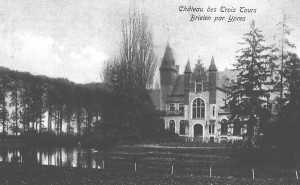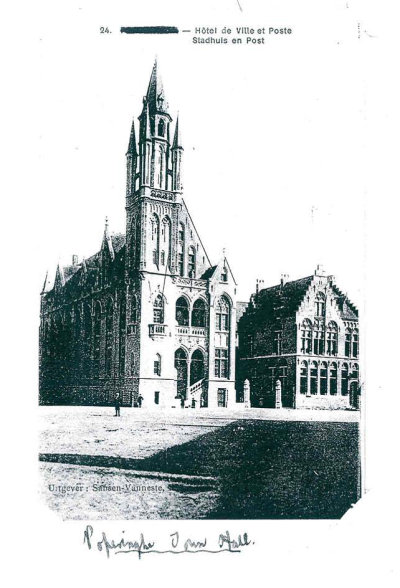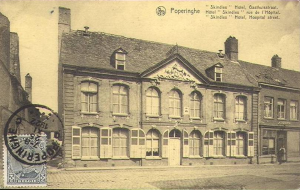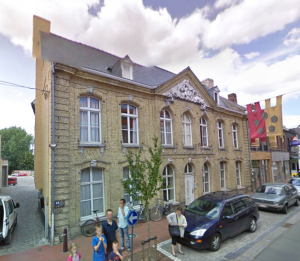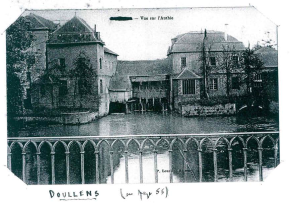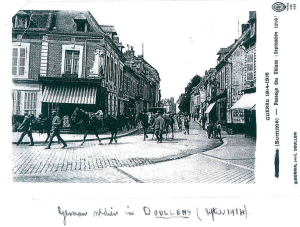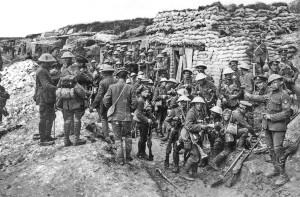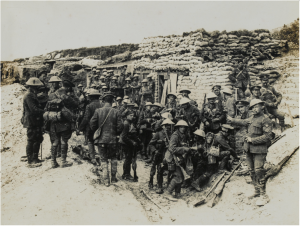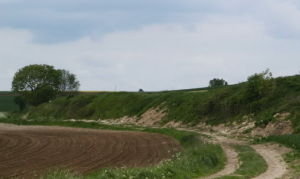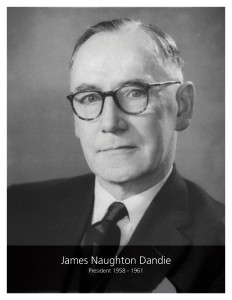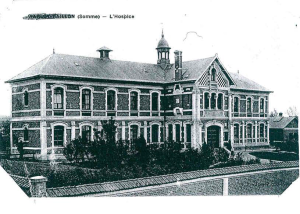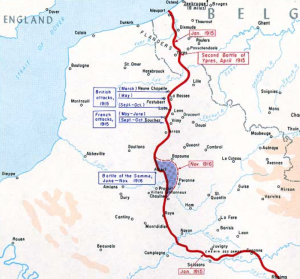WW1 Diary
20th August 1916 Sunday
All material produced or reproduced here and throughout this work is the sole copyright of the author and the family of Doctor D.C.M. Page MC.
“At 10 o’clock on the evening of August 20th we stealthily left the camp and marched into Poperinghe where we entrained for Vlamertinghe. Our train was an armoured one with all lights out, and we rushed through the night at express speed. From Vlamertinghe we marched along a very much shell-holed road to our new abode “The Chateau des Trois Tours”, close to the shell-battered village of Brielen. My medical inspection room was in the stables adjoining the chateau, which was quite an imposing building, quite untouched by shell fire, strange to relate. It was rumoured that the building belonged to a German, hence its intact condition. Anyhow it was quite a comfortable billet for us with its big airy rooms, and large fireplaces, where we indulged in roaring fires when the chilly evenings arrived. Headquarters staff occupied the Chateau whilst the companies occupied shell-battered farm houses and cottages round about. One company was in good dug-outs on the Canal (Yser) Bank, about 2-3 miles across country from us, and nearer the enemy, of course.”
Find out about our connection with Dr Page and an introduction to his diary here
6th to 19th August 1916
All material produced or reproduced here and throughout this work is the sole copyright of the author and the family of Doctor D.C.M. Page MC.
“On August 6th, in brilliant sunny weather we moved about a mile forward into “L Camp”. It was rather crowded as the 15th, and 16th RWF (Royal Welsh Fusiliers) were in the same camp. I shared a tent with the Padre, and here we remained resting, refitting and recuperating after the Somme Battle until the 20th of the month. I had lots to do in training new stretcher-bearers, planning latrines, lecturing to the troops on health matters, inoculating officers and men against typhoid, etc. The weather was generally very hot and sunny and we soon got well tanned.
In the evenings we usually went into “Pop” for dinner at “Skindles” and when we got back to camp had great rags – letting down tents on peacefully-sleeping occupants etc.
HM King George V passed by our camp on the 15th in a large car, but didn’t stop to inspect us. We gave him a great cheer.”
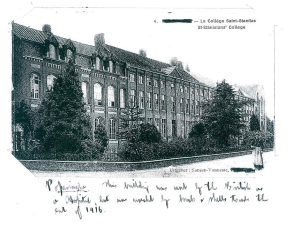
Poperinghe: this building was used by the British as a hospital, but was wrecked by bombs and shells towards the end of 1916
Find out about our connection with Dr Page and an introduction to his diary here
31st July 1916 to 5th August 1916
All material produced or reproduced here and throughout this work is the sole copyright of the author and the family of Doctor D.C.M. Page MC.
“We entrained at Doullens at 6.20pm and reached Poperinghe in Belgium at 1.30am on July 31st. It was a tedious journey. After detraining we marched about 8 miles out of Belgium into France to a little village named Houtkerque – a pretty little place, where I established a Medical Inspection Room in a deserted butcher’s shop.
Here we rested for a couple of days, and then trekked five miles to a hut encampment in a wood near Poperinghe – quite a pleasant spot. We had four days of rest here, but I was kept busy attending to the health of the troops – baths, foot inspection, inoculations etc, – and the camp sanitation.
Poperinghe – 4 miles distant – I visited one day. It was quite a large-sized town, but damaged a good deal by shell-fire. The shops weren’t very good. Dinner at “Skindles” was very good, however.
The Divisional Baths were very meagre, and were erected by the Guards Division. The Prince of Wales had a bath there only a week ago.”
Poperinghe as it was spelt during WW1 is now Poperinge, but in those terrible years it was called “The last stop before Hell”. Although Poperinghe was never in German hands it was occasionally subject to heavy German shelling, but represented a comparative safe haven to British and allied troops. Today on Gasthuisstraat you can still see the building that during the Great War was a café or club, popular with officers called “Skindles”.
Skindles like so many places on the Western Front was an anglicised nickname given to a local place to make the men feel more at home. It was named after a famous hotel on the bank of the Thames in Maidenhead. To Douglas and his comrades it was to become a regular haunt. Meanwhile the rest of Poperinghe, provided many other places of essential respite like shops, restaurants, cafes or estiminets, cinemas and concert halls and not a few brothels.
Find out about our connection with Dr Page and an introduction to his diary here
29th July 1916 Saturday
All material produced or reproduced here and throughout this work is the sole copyright of the author and the family of Doctor D.C.M. Page MC.
“Next day we were on the move again – a 2½ hours’ march to Sarton – another respectable village, where I got a good billet. On again in terrific heat from a scorching sun to Doullens. This was a cruel march for the men in full war kit – steel helmets, etc, and many fell out en route, suffering from sun-stroke, fatigue and sore feet. I had a most hectic time getting lifts for them in passing ambulances, lorries and French carts.”
Find out about our connection with Dr Page and an introduction to his diary here
28th July 1916 Friday
All material produced or reproduced here and throughout this work is the sole copyright of the author and the family of Doctor D.C.M. Page MC.
“We remained in the line until Friday, July 28th, and during our four days’ turn of duty I visited all the companies up in the front line. On one occasion I had a hot time being caught in a nasty shrapnel barrage at one point, and then landing amongst some heavy stuff at another. It was “windy” work, but I got safely back to White City. Parts of the front line trench were non-existent as a result of the enemy trench-mortar bombardment, and one had to crawl across these gaps to escape observation from the German snipers. It was exciting.
A Somerset Battalion relieved us on the 28th, and we proceeded via Courvelles to Bus, a nice, wee village, where the battalion was accommodated in huts. All the officers slept in one big hut, and as I had my camp bed with me, I was all right. I rode on to Sailly as soon as possible, and had a bath.”
Find out about our connection with Dr Page and an introduction to his diary here
25th July 1916 Tuesday
All material produced or reproduced here and throughout this work is the sole copyright of the author and the family of Doctor D.C.M. Page MC.
“Next day (July 25th) I moved my Aid Post down to an old gun-pit near White City. It was quite a good spot, and had an excellent dug-out, fully 20ft deep for using during shelling on the enemy’s part.”
Find out about our connection with Dr Page and an introduction to his diary here
24th July 1916 Monday
All material produced or reproduced here and throughout this work is the sole copyright of the author and the family of Doctor D.C.M. Page MC.
“We packed up about noon on the 24th – and moved into the trenches in front of Auchonvillers. It was a long trail – about 7 miles – and I was at the rear of the column, as usual. Just as we were approaching Battalion Headquarters at White City and going down the communication trench, named Fifth Avenue, the Huns spotted us, and started shelling with whizz-bangs. We got merry Hell for 20 minutes, and I thought my last minute had come. We lay like pancakes at the foot of the trench till it was all over. Four men were killed and three wounded. They belonged to the 9th Fusiliers whom we were relieving. The trenches were blown in. I attended to them and sent the wounded men back in charge of stretcher-bearers. Then I went on to my Aid Post which was fully 400 yards from Headquarters at *White City, at the junction of Mount Joy Avenue and Roman Road. It was a hopeless place, and I found that I couldn’t get a stretcher into the dug-out. Then the Huns started to drop shells all round the place – great big “crumps”. They smashed up our engineers’ dump close by – picks, shovels, wheel-barrows etc, were flying all over the place, and the trench was knocked in. With my stretcher-bearers I took refuge in a 20ft deep dug-out near at hand. Whilst disappearing into this refuge I was violently struck by a piece of something hard – wheel-barrow, shovel, shell, I know not – on the back. This helped to accelerate my descent into the lower regions, and luckily only badly bruised me and gave me a fright.
It felt safe down there, but I didn’t like the way the whole place shook and the candles went out when a big shell dropped over-head. The place was full of rats too, which didn’t add to one’s comfort. Twice during our first night in the line the Huns shelled that dump, and I had the “wind-up” properly. We had one man killed, one wounded, and one shell-shocked during the night. About 11pm the Huns did a lot of damage in our front line with trench-mortars. Our field guns gave them HELL for 4 minutes, which soon stopped their nonsense.”
*White City was a dressing station that was so called because it was dug into a chalk ridge, near Beaumont Hamel.
Find out about our connection with Dr Page and an introduction to his diary here
18th July 1916 Tuesday
All material produced or reproduced here and throughout this work is the sole copyright of the author and the family of Doctor D.C.M. Page MC.
“On the 18th July, we marched into Happy Valley – a dismal hole, full of troops. I managed to “acquire” a moth-eaten bell-tent and made myself as comfortable as possible. Here I met my old school pal, *Jimmy Dandie, whose battery of heavy guns was situated about a mile from us at Colincamps. We had a great yarning together, and he had tea and dinner with us – the latter meal we partook of in the Field Ambulance Dressing Station Mess on the hill-side. Here the Battalion rested until July 24th. I had huge sick parades each day – 60-80 strong – but there were no cases of serious illness.”
*Douglas had attended George Watson’s College in Edinburgh with James Dandie. James Naughton Dandie saw the whole of the war on the front, having served since 1914 with the Royal Garrison Artillery.
Born in 1894, he was the same age as Douglas and had a distinguished career both in the war where he became Acting Captain and like Douglas won the Military Cross. By the time of the second world war he was practising as a solicitor in the Stirling area, later becoming President of the Law Society of Scotland and lived until 1976.
Find out about our connection with Dr Page and an introduction to his diary here
13th-15th July 1916 Thursday to Saturday
All material produced or reproduced here and throughout this work is the sole copyright of the author and the family of Doctor D.C.M. Page MC.
“We left Morlancourt on July 13th. Before we left the Bantam Division came into the village. I saw some of the Edinburgh “Bantams” but hadn’t time to look for Gordon Sturrock. We marched via Ville, Buire, Lavieville and Henencourt to Warloy. We had a triumphal procession. Some of our men carried captured German helmets, caps & c and in the villages we passed through the battalions turned out and gave us a great reception. A great body of cavalry passed us going towards the front. We cheered them on, and they gave us a cheer. When we got to Warloy about 10.30pm we found that the Brigade had gone on in motor buses to an unknown destination! We were left behind, forgotten and uncared for!
However, we got hold of the Town Mayor, who found us billets, and food. I had a heavy doze of cold, and felt pretty miserable. Heard that the 3rd, 7th and 21st Divisions attack the German 2nd line at dawn tomorrow. We rested all next day (July 14th) in Warloy and I spent most of the day in bed trying to get rid of my cold.
On 15th July we got word from Headquarters to proceed to Thievres and I was conveyed there in an old field ambulance feeling pretty miserable with a sore throat and bunged up head. No sooner had I rejoined the 130th Field Ambulance than I was pushed off to Authie to do duty as Medical Officer with the 13th Royal Welsh Fusiliers. Their Doctor, Capt. Lawrence – was killed in Mametz Wood. The Commanding Officer – Col. Campbell – was a Scot, and a right good sort. I got a good billet.
The Battalion only remained in Authie village for two days. On one day we were inspected by Major General Hunter-Weston the Corps Commander, and on the other I got 200 men of the Battalion bathed at the baths at Covin. I had a grand, hot bath myself!
I was also busy with big sick-parades – most of the men were badly nerve-shocked after the ordeal of Mametz Wood – reorganising the stretcher-bearers and procuring fresh medical stores.”
After the 13th July Douglas describes the men on the move, sick, injured and practically exhausted after the trauma of Mametz Wood. In fact they had suffered so much that the whole 38th Welsh division was withdrawn from frontline combat for a year and didn’t fight again until 1917. They made their way slowly back behind the lines to Poperinghe, west of Ypres which was considered to be safe in British hands, at least for the time being.
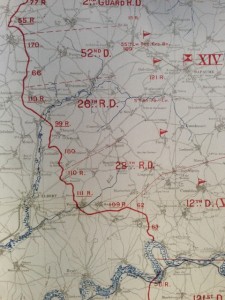
Map of German positions on the Somme. Reproduced with the permission of the National Library of Scotland. https://maps.nls.uk/index.html
Find out about our connection with Dr Page and an introduction to his diary here
11th-12th July 1916 Tuesday & Wednesday
All material produced or reproduced here and throughout this work is the sole copyright of the author and the family of Doctor D.C.M. Page MC.
“All that night and all next day (11th July) and night right up till 9 0’clock on Wednesday, July 12th we were busy getting all our wounded and evacuating them.
On both nights 100 cavalry men came up to clear the wounded from Caterpillar Trench, but they weren’t of much use to us as they were all, officers included, all terribly ‘windy’ and scattered whenever a shell dropped anywhere near them. They had never been under fire before.
I saw the 14th Welsh come out of the wood – 180 strong – and only two officers to lead them. The 13th Welsh came back about 200 strong. It was a terrible sight. The cold was intense, both nights we got no sleep. I felt pretty rotten by 9 o’clock on 12th July when we were relieved as I’d had no sleep for three days and nights and had been on my feet practically all that time, attending to wounded. Food hadn’t been plentiful either, except tea and biscuits, but a bottle of brandy and a slab of chocolate spun out over three days, helped to keep spirits up.
On our relief we trudged wearily up to Minden Post. Then the Huns shelled us heavily and wounded a few men slightly. We were all so tired that we could hardly throw ourselves into shell-holes to get cover. In fact, I think we were so dazed that we didn’t bother what happened to us. We stood on the crest of the hill for a moment to watch the Huns shelling Contalmaison. We were promised motor lorries to convey us back to Morlancourt, but none appeared and we had to send them down in relays of motor ambulances. The result was that I didn’t get down till 3 o’clock in the afternoon, but I got some good hot food and felt better.
Colonel Davies and some officers left for Mericourt to entrain for Veuchelles near Langpre between Amiens and Abbeville. Our wearied stretcher-bearers with myself and other officers were left behind to rest and were very kindly treated by the 23rd Field Ambulance, officers and men. I had a shave and a good wash and bedded down in a tent at 6pm – dead beat! The 38th Division, although practically wiped out, did its job and captured Mametz Wood. The 113th *Brigade mustered up a little more than a thousand men after the battle.
They went in over 3000 strong. The Divisional General – **Major General Phillips – was sent home on 9th July- incompetence.”
*A Brigade would normally consist of 3000 to 4000 men, made up of usually four battalions. Two brigades would make up a division.
** General Ivor Phillips was mentioned in earlier posts see here and here
Find out about our connection with Dr Page and an introduction to his diary here
